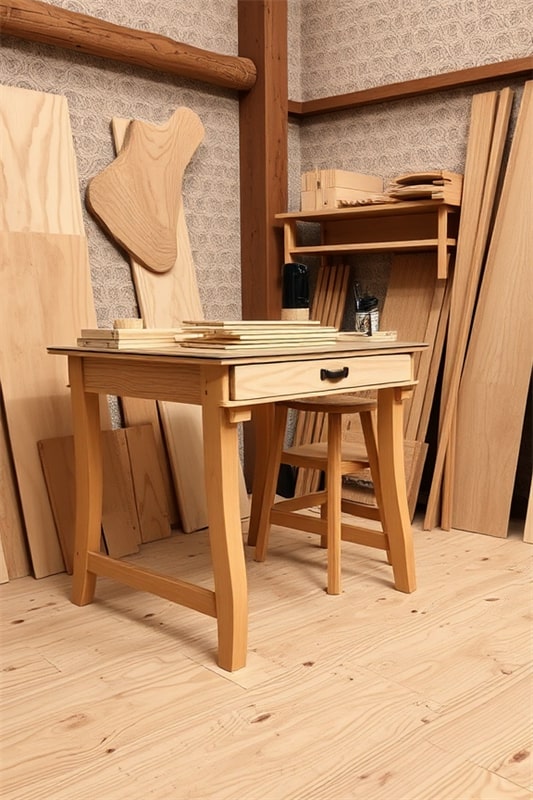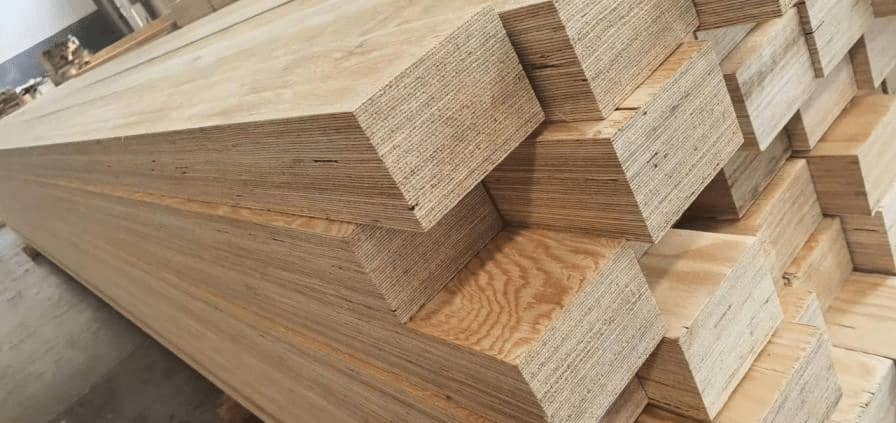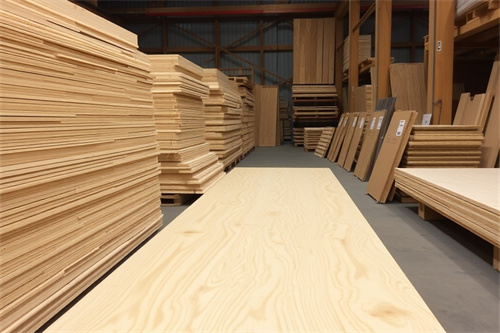In the realm of engineered wood products, laminated veneer lumber (LVL) stands as a testament to human ingenuity, transforming readily available resources into building materials of exceptional strength, versatility, and sustainability. Among the many forms LVL takes, slats have emerged as essential components in countless applications, from framing sturdy structures to crafting elegant furniture pieces. This comprehensive guide delves deep into the world of LVL slats, exploring their manufacturing process, unique advantages, diverse applications, and the factors to consider when choosing the perfect slats for your project.
Understanding the Essence of LVL Slats
LVL slats begin their journey as carefully selected logs, primarily from softwood species like Douglas fir, Southern pine, and Yellow poplar, known for their straight grain and consistent density. These species are favored for their strength-to-weight ratio, availability, and suitability for the peeling process. The transformation from raw timber to high-performance building material involves a series of meticulously controlled steps:
- Veneer Peeling: The selected logs are first softened using steam or hot water, making the wood more pliable for peeling. They are then mounted on a rotary lathe, a specialized machine equipped with a sharp blade that peels the log into continuous, thin sheets of veneer. This process ensures consistent veneer thickness, a crucial factor in the structural integrity of the final LVL product.
- Drying and Grading: The peeled veneer sheets retain a significant amount of moisture, which needs to be reduced to a specific level for optimal bonding and dimensional stability. The veneers are carefully dried in large kilns, where temperature and humidity are precisely controlled to prevent warping, cracking, or other defects. Once dried, the veneers are meticulously inspected and graded based on their quality, with higher grades reserved for structural applications demanding greater strength and stiffness.
- Layering and Bonding: This stage is where the magic of LVL truly unfolds. The dried and graded veneer sheets are arranged in layers, with the grain direction of each layer running parallel to one another. This parallel grain orientation is the key to LVL’s exceptional strength and stiffness in a single direction, making it significantly stronger than solid lumber, where the grain direction varies naturally. The layered veneers are then coated with a strong, moisture-resistant adhesive, typically phenol-formaldehyde resins chosen for their bonding strength and durability. The adhesive is applied uniformly across each layer to ensure a consistent bond throughout the entire LVL slat.
- Pressing and Curing: The layered and bonded veneer stack is then transferred to a massive hydraulic press, where it is subjected to immense pressure. This pressure serves two crucial purposes: it compresses the veneer layers, removing any air pockets and creating a dense, homogenous material, and it ensures a strong, permanent bond between the veneers and the adhesive. The pressed slats are then moved to a controlled curing environment, where the adhesive is allowed to fully cure and reach its maximum strength. The curing time and temperature are carefully controlled to ensure optimal bond strength and prevent internal stresses within the LVL slat.
- Finishing and Quality Control: After curing, the LVL slats emerge from the press as large, solid billets. These billets are then cut to their final dimensions using precision saws, ensuring accuracy and minimizing waste. The surfaces of the slats are typically sanded smooth, removing any imperfections and preparing them for finishing. Throughout the manufacturing process, rigorous quality control measures are employed at each stage to ensure that only the highest quality LVL slats, meeting stringent industry standards, reach the market.
Unveiling the Advantages of LVL Slats
The sophisticated manufacturing process of LVL slats endows them with a unique combination of advantages that make them a superior choice over traditional lumber and other building materials in a wide range of applications:
- Exceptional Strength and Stiffness: The parallel grain orientation of the veneer layers, combined with the strong adhesive bond, results in exceptional strength and stiffness, particularly in the direction of the grain. This directional strength makes LVL slats significantly stronger than solid lumber of the same dimensions, especially when used as beams, headers, or other structural elements where they need to resist bending or sagging under load.
- Dimensional Stability: One of the inherent weaknesses of traditional lumber is its susceptibility to dimensional changes due to fluctuations in temperature and humidity. Wood naturally expands and contracts with changes in moisture content, leading to warping, twisting, or bowing, which can compromise the structural integrity of a building over time. LVL slats, on the other hand, are engineered for dimensional stability. The manufacturing process removes much of the wood’s natural tendency to expand and contract, resulting in a material that remains straight and true even in challenging environmental conditions.
- Availability in Long Lengths: Traditional lumber is limited in length by the size of the trees from which it is harvested. This limitation often necessitates joining multiple pieces of lumber together to achieve the desired span, increasing labor costs and introducing potential weak points in the structure. LVL slats, however, can be manufactured in much longer lengths than traditional lumber, often exceeding 60 feet. This allows for greater design flexibility, reduces the need for joints, and simplifies installation, especially in applications requiring long, uninterrupted spans.
- Consistent Quality: Solid lumber, being a natural product, exhibits inherent variations in strength and quality. Knots, grain irregularities, and other natural defects can weaken the wood, making it difficult to predict its exact load-bearing capacity. LVL slats, in contrast, offer consistent quality from slat to slat. The manufacturing process eliminates natural variations, resulting in a predictable and reliable material. This consistency gives engineers and builders confidence in the structural integrity of their designs.
- Design Flexibility: LVL slats are not limited to standard lumber dimensions. They can be manufactured in various sizes and thicknesses to meet specific project requirements. This allows for greater design flexibility, enabling architects and engineers to optimize their designs for strength, weight, and cost-effectiveness. Additionally, LVL slats can be easily cut, shaped, and drilled using standard woodworking tools, making them adaptable to a wide range of applications.
- Sustainability: In an era of increasing environmental awareness, the sustainability of building materials is paramount. LVL slats offer a compelling sustainability profile. They are made from a renewable resource – wood – and the manufacturing process is highly efficient, utilizing nearly 100% of the log, minimizing waste. Furthermore, many LVL slat manufacturers are committed to responsible forestry practices, sourcing their timber from sustainably managed forests that are certified by organizations like the Forest Stewardship Council (FSC) or the Programme for the Endorsement of Forest Certification (PEFC).
Exploring the Diverse Applications of LVL Slats
The exceptional strength, dimensional stability, and design flexibility of LVL slats make them a preferred choice for a wide range of applications across various industries, serving the needs of architects, builders, contractors, furniture makers, and DIY enthusiasts alike:
Construction and Building:
- Beams and Headers: LVL slats excel as beams and headers in residential and commercial construction, providing essential structural support over doorways, windows, and other openings. Their high strength-to-weight ratio allows them to carry heavy loads over long spans without excessive deflection, making them ideal for open floor plans, large windows, and vaulted ceilings. Their dimensional stability ensures that floors and ceilings remain level and true, preventing cracking or sagging over time.
- Floor Joists and Rafters: LVL slats are increasingly replacing traditional lumber as floor joists and rafters in modern construction. Their strength and stiffness allow for wider joist spacing, reducing material costs and allowing for greater flexibility in plumbing and electrical installations. Their dimensional stability ensures a level surface for flooring and a straight roofline, minimizing squeaks and other issues associated with wood movement.
- Window and Door Headers: Supporting the weight of the wall above windows and doors is crucial for structural integrity. LVL slats, with their high strength and dimensional stability, are ideal for use as window and door headers, providing a robust and reliable lintel that can withstand the weight of the structure above without sagging or deflecting.
- Ridge Beams and Purlins: In roof construction, LVL slats are used as ridge beams, running along the peak of the roof to support the rafters, and purlins, which provide horizontal support for the roof decking. Their strength and stiffness make them suitable for a variety of roof designs, including vaulted ceilings and complex rooflines.
- Stair Stringers and Treads: LVL slats can be used to create strong, durable stair stringers, the backbone of a staircase that supports the treads and risers. Their dimensional stability ensures that the stairs remain level and safe over time. LVL slats can also be used for the treads themselves, providing a hard-wearing and attractive surface that can withstand heavy foot traffic.
Furniture Making:
- Tabletops and Desks: LVL slats offer a unique combination of strength, stability, and aesthetics for furniture making. They can be used to create sturdy, long-lasting tabletops and desks that can withstand the rigors of daily use. Their smooth, consistent surface provides an excellent base for a variety of finishes, allowing furniture makers to achieve a range of styles and aesthetics.
- Shelving and Bookcases: LVL slats are ideal for building heavy-duty shelving and bookcases that can support the weight of books, tools, or other heavy items. Their dimensional stability ensures that shelves remain straight and true over time, preventing sagging or bowing under load.
- Bed Frames and Headboards: LVL slats can be used to create durable and stylish bed frames and headboards that can withstand the weight of heavy mattresses and the rigors of everyday use. Their strength and stability make them a reliable choice for supporting one of the most important pieces of furniture in a home.

Other Applications:
- Truck and Trailer Decking: The transportation industry demands materials that can withstand heavy loads and frequent use. LVL slats, with their high strength-to-weight ratio and durability, are used for truck and trailer decking, providing a robust and reliable platform for transporting goods.
- Shipping Crates and Pallets: LVL slats are used in the manufacturing of shipping crates and pallets, providing a strong and reliable base for transporting goods. Their durability and resistance to moisture make them suitable for a variety of shipping environments.
- Scaffolding Planks: Safety is paramount in construction, and scaffolding planks need to provide a stable and reliable platform for workers. LVL slats are sometimes used as scaffolding planks due to their strength and stiffness, ensuring worker safety at height.
Factors to Consider When Choosing LVL Slats
Selecting the right LVL slats for your project is crucial for ensuring optimal performance, safety, and longevity. Here are key factors to consider:
- Load-Bearing Requirements: The most critical factor is the load-bearing capacity required for your application. LVL slats are available in various grades and thicknesses, each with a specific strength rating expressed in pounds per square inch (psi). Consult with a structural engineer to determine the appropriate grade and size for your project, considering the expected loads, span lengths, and building codes in your area.
- Span Requirements: The length of the span, or the distance the slat needs to cover without intermediate support, also influences the choice of LVL slat. Longer spans typically require thicker slats or slats with a higher strength rating to prevent excessive deflection or sagging.
- Moisture Content: LVL slats are typically kiln-dried to a specific moisture content to minimize shrinkage and swelling. The ideal moisture content for your application depends on the expected environmental conditions. For interior applications in dry climates, a lower moisture content is suitable. For exterior applications or applications in humid environments, a higher moisture content is recommended to minimize the risk of shrinkage or cracking.
- Treatment Options: LVL slats can be treated with preservatives to enhance their resistance to moisture, insects, and decay. Untreated slats are suitable for interior applications in dry conditions. However, for exterior applications or applications where the slats will be exposed to moisture, such as decks, porches, or roof overhangs, treated slats are essential to prevent rot, decay, and insect infestation. Treatment options may include water-resistant preservatives, fire retardants, and insecticides, depending on the intended application and local building codes.
- Sustainability Certifications: If environmental responsibility is a priority, look for LVL slats that are certified by organizations like the Forest Stewardship Council (FSC) or the Programme for the Endorsement of Forest Certification (PEFC). These certifications provide assurance that the wood used to manufacture the slats comes from responsibly managed forests that meet strict environmental and social standards.
Working with LVL Slats: Tips for Success
While LVL slats offer numerous advantages, it’s essential to handle and install them correctly to ensure optimal performance, safety, and longevity:
- Storage and Handling: Proper storage and handling are crucial for maintaining the quality and integrity of LVL slats. Store them in a dry, well-ventilated area, protected from direct sunlight, rain, and excessive humidity. When handling LVL slats, lift them carefully to avoid damaging the edges or surfaces. Use appropriate lifting techniques and equipment to prevent back injuries, especially when handling long or heavy slats.
- Cutting and Drilling: LVL slats can be cut and drilled using standard woodworking tools. However, due to their density, it’s recommended to use sharp, carbide-tipped blades and drill bits to prevent excessive wear and tear on tools and ensure clean, accurate cuts. When drilling, use a pilot hole to prevent splitting, especially when drilling near the edges of the slat.
- Fastening: Use appropriate fasteners, such as screws or nails, specifically designed for use with engineered wood products. Consult with your LVL slat supplier or a structural engineer to determine the correct type, size, and spacing of fasteners for your application, considering the load requirements and the type of material being fastened to the LVL slat.
- Finishing: LVL slats can be finished with paint, stain, or varnish, just like traditional lumber. However, it’s essential to use high-quality finishes specifically designed for exterior use if the slats will be exposed to the elements. Before applying any finish, ensure the surface of the slat is clean, dry, and free of dust or debris. Follow the manufacturer’s instructions for applying the finish, including the recommended number of coats and drying times.
Why Choose Yuantuo Wood for Your LVL Slat Needs?
You’ve delved into the intricacies of LVL slats, their manufacturing, advantages, and diverse applications. Now, let’s explore why Yuantuo Wood should be your trusted partner in harnessing the strength and versatility of this remarkable building material.
Yuantuo Wood: Where Quality Meets Sustainability
We understand that choosing the right LVL slats is crucial for the success of your project. That’s why at Yuantuo Wood, we go beyond simply supplying building materials; we provide solutions backed by:
- Uncompromising Quality: Our LVL slats are manufactured using premium veneers and state-of-the-art technology, adhering to stringent quality control measures at every stage, from sourcing sustainable timber to precision cutting and finishing. This ensures consistent strength, dimensional stability, and long-lasting performance for your peace of mind.
- Tailored to Your Needs: We offer a comprehensive range of LVL slat grades, sizes, and treatment options to meet the specific demands of your project, whether it’s a residential build, a commercial structure, or a custom furniture piece. Our team provides expert guidance in selecting the optimal slats for your load-bearing requirements, span lengths, and environmental conditions.
- Sustainability at Our Core: We believe in responsible forestry practices and source our timber from sustainably managed forests certified by the FSC or PEFC. By choosing Yuantuo Wood, you contribute to preserving our planet’s precious resources for generations to come.
- Dedicated Support: Our commitment to your satisfaction extends beyond the point of sale. Our experienced team provides comprehensive support, from product selection and technical advice to timely delivery and after-sales service. We are your partners in building success.
Choose Yuantuo Wood for:
- Exceptional Strength and Durability: Build with confidence, knowing that our LVL slats deliver exceptional strength and long-lasting performance, even in demanding applications.
- Dimensional Stability for Lasting Beauty: Create level floors, straight walls, and true rooflines that maintain their structural integrity and aesthetic appeal for years to come.
- Sustainable Building Solutions: Reduce your environmental footprint by choosing LVL slats crafted from responsibly sourced timber, reflecting your commitment to a greener future.
- Unwavering Support for Your Vision: Benefit from our expertise, guidance, and reliable service throughout your project, ensuring a smooth and successful building experience.
Contact Yuantuo Wood today to discuss your LVL slat requirements. Let us be your trusted partner in building a stronger, more sustainable future.
FAQs: Addressing Common Queries about LVL Slats
1. What makes LVL slats stronger than traditional lumber?
LVL slats derive their superior strength from the manufacturing process. Unlike solid lumber, where the grain runs randomly, LVL slats are engineered with layers of thin veneer sheets glued together with the grain running in the same direction. This parallel grain orientation, combined with the strong adhesive bond, significantly increases their strength and stiffness, particularly in resisting bending and sagging under load.
2. Can LVL slats be used for both interior and exterior applications?
Yes, LVL slats can be used for both interior and exterior applications, but the choice of treatment is crucial. Untreated LVL slats are suitable for dry, interior environments. However, for exterior applications or areas exposed to moisture, such as decks, porches, or roof overhangs, treated LVL slats are essential. These are treated with preservatives to resist moisture, insects, and decay, ensuring long-term performance in challenging conditions.
3. Are LVL slats a sustainable building material?
Yes, LVL slats are considered a sustainable building material for several reasons. Firstly, they are made from a renewable resource – wood. Secondly, the manufacturing process is highly efficient, utilizing nearly 100% of the log and minimizing waste. Additionally, many LVL slat manufacturers are committed to responsible forestry practices, sourcing their timber from sustainably managed forests certified by organizations like the FSC or PEFC.
4. Do I need special tools to work with LVL slats?
While LVL slats can be cut and drilled using standard woodworking tools, their density requires some considerations. Using sharp, carbide-tipped blades and drill bits is recommended to prevent excessive wear and tear on tools and ensure clean, accurate cuts. When drilling, using a pilot hole, especially near the edges, can prevent splitting.
5. Where can I find information about the load-bearing capacity of LVL slats for my project?
Each LVL slat grade and thickness comes with a specific strength rating, typically expressed in pounds per square inch (psi). This information is crucial for determining the appropriate slat for your project’s structural requirements. Consult with your LVL slat supplier or a structural engineer to determine the correct grade, size, and spacing for your application, considering the expected loads, span lengths, and local building codes.



